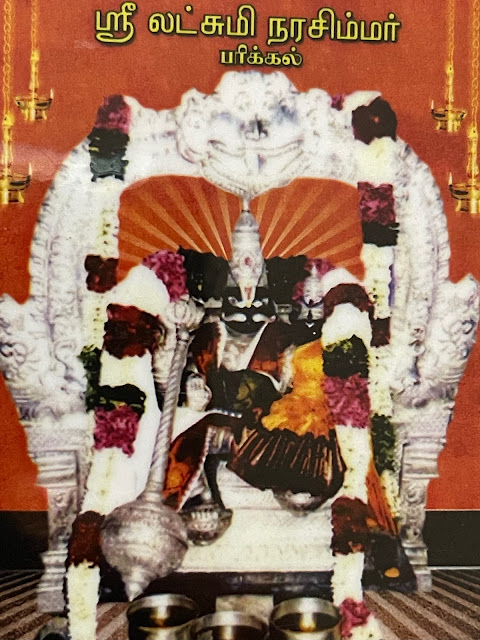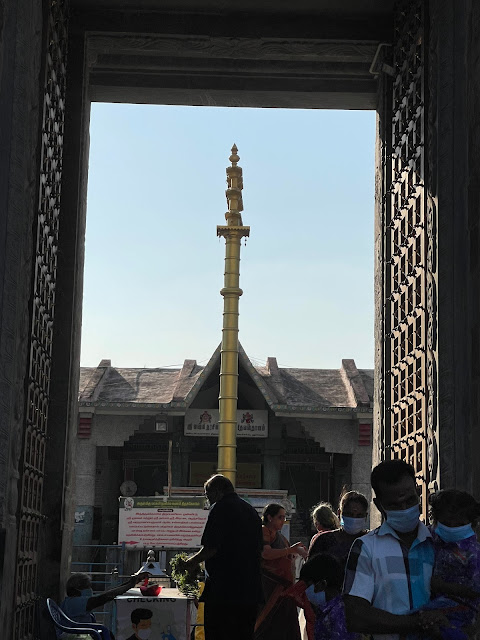I had visited Badrinath
temple this month and I wish to confine myself only about Badrinath temple in
this post leaving the travel details to my travel blog.
Badrinath, the abode of
Sri Badri Narayan is situated at a height of 3133 mts above sea level in the
state of Uttarakhand. This temple is nestled between the two mountains Nar and
Narayan of the Garhwal range and on the banks of river Alaknanda.
It is believed that Sri
Vishnu came down to this earth to meditate and His Consort Sri Lakshmi, took
the form of a Badri tree to give him shade and protection from sun and rain. As
a result, the lord came to be known as Badrinarayan.
It is held that the
Buddhists threw away the idol of Badri Narayan in the Narada kund on the banks
of Alaknanda and believed that a divine voice had instructed Adi Shankaracharya
to retrieve the idol of the deity and reinstall it in the temple. He carried
out the divine wish willingly thus giving the devotees a chance to have the
divine darshan.
Here the guru sishya
parampara can be seen in a beautiful context. The lord took the forms of both
Narayanan –the preceptor and Nara – the perceiver, to propagate the powerful
asthakshara mantra.
One can see this
overpowering presence of Nar and Narayan as the two mountains on either side of
Alaknanda.
This temple is open only
from April to November as the winter sets in thereafter with the place fully
covered in snow making it impossible for anyone to live here. The day of
opening and closing of the temple is decided by the trust. When they close the
temple for winter, the Namboodri, the chief priest, does the puja after
lighting a lamp with some ghee for it to burn and glow for a while. The uddhav
murti is taken down in procession to Joshimath and kept there for the next six
months.
When the opening is
announced, the uddhav murti is first taken to the Mata mandir to pray to His
mother and from there the Namboodri and the whole entourage reach the
temple that is opened in public view. The most surprising event or a miracle
you can say is the phenomenon of the lamp lit six months before still glowing.
This defies a rational explanation as the temple was fully closed with no scope
of air entering the sanctum. Can anyone explain this marvel except by
attributing to the Divine presence? It is believed that sage Narada performs
puja for these six months when we cannot enter the terrain and the temple is
closed. Hence this is also called as Narada Kshetram
A trip to Badrinath has
always been on my mind ever since we embarked on a visit to 106 Divya Desams
and I thought what better way to celebrate KK’s 50th birthday than having the
darshan of Sri Badri Narayan on that special day and invoking His blessings.
Once this thought struck me, I started to plan for the holy trip and with His
blessings, things started falling in place. KK could avail the leave and we
found a good travel agent, who booked rooms according to my choice. We planned
the weeklong trip to ensure we were at Badrinath on KK’s birthday.
The trip was very
enjoyable and exciting as we travelled from Dehradun to Badrinath by road
visiting many other places along the route. The constant company all the way
was the imposing Garhwal range of mountains and the beautiful rivers flowing
beneath. Some of the stretches of the roads are really risky but the adept
drivers of the vehicles that ply on these ghat sections are equal to the task
and of course you have HIS blessings. So our mantra was just to relax and live
in the moment, enjoying the scenic beauty and waiting for His darshan!

We reached Badrinath by
12. noon and checked into Sarovar Portico (Sarovar group of hotels). One of the
best hotels here, and the service was good too. After lunch, we
proceeded to Mana village, which is the last village of Indian Territory,
details of which will be on my travel blog soon. We explored the village, saw
the pristine beauty of nature and came back to see the temple we were waiting
for all these days, the Badrinarayan temple.
You will need to walk
5-7 minutes from the parking lot to reach the temple premises. All along the
path, you will see shops selling trinkets, prasad and numerous pictures of the
temple and the deity. As we pass these shops, you will see Alaknanda flowing in
all her majesty, with its water greenish blue in colour and what a sight to
watch her. As you cross her over the bridge, you see on your right side towards
the end of the bridge smoke coming down from below, and then we realize that it
was coming from the hot Sulphur springs of Tapt kund. Devotees have a dip in
the hot spring, before heading for the darshan of Sri Badri Narayan. Then a
flight of steps, and you will reach the temple doorway. On the left you can
find the temple office kiosk, where you can buy the tickets for the sevas that
are offered on that day. It is advisable to be prepared with enough cash as
they do not accept credit/debit cards.
 |
| That is the steam coming out of the hot springs |

The temple is way
different from what you see in South India. The main entrance of the temple is
unique and very colourful and is known as SINGHDWAR. The temple is 50 feet tall
and has a cupola on top covered in a golden coloured roof.
We can see a sankhu (conch), chakram (wheel) and an Aum on the
façade of the temple. Tiruman (namam) is conspicuous by its absence. The panels
near the door are engraved with dasavatharam. It is said that everyone is
allowed in the temple. There is no bar on the basis of religion, caste and
creed, reiterating the fact that He is Universal, the supreme and is one for
all.
As we waited in the
queue, the day was receding and the chilly night was ready to freeze us. Armed
with enough winter clothing, we braved the cold weather and the only thing that
kept our spirit high was the anticipation of the much awaited darshan.
They let us inside the
hall in front of the sanctum sanctorum. Luckily we sat right in front of the
deity. I do not remember what happened in the next few minutes. I just kept
gazing at Him as if on a mental dialogue between him and me. Nothing else occurred
or mattered. I was oblivious of the surroundings till nudged by KK that the
puja had started. It was then I started observing everything inside the
sanctorum.
In the center is the
saligrama idol of the presiding deity decked up in all grandeur and finery. He
is seated in Padmasana posture with sankha and chakra in two hands. He is a
swayambhu and is dark in colour. On his right side we see a golden face of Sri
Kubera and a Garuda in silver praying with folded hands. On his left we see an
idol of Uddhav and a small idol of sage Narada. On his extreme left we can see
the idols of Nar and Narayan.
The chanting of
sahasranamavali started and the priests seated outside started to chant
sahasranamam while the Namboodri performed the puja inside. Only the Namboodri,
who hails from the same clan as Sri Adi Shankaracharya, is allowed inside the
sanctorum. For those unable to see the puja properly inside, they have made
arrangements to telecast it live on a big television erected on the either side
of the entrance to the sanctum. While you watch the puja on the television
sets, your eyes cannot escape the beautiful dwara palakas seen on either side
of the entrance of the sanctorum and they look very much like the ones you see
in the South Indian temples.
The walls of the sabha
mantap where the devotees assemble are covered with intricately carved designs
and is very beautiful
After the puja and the
arathi, we were given prasad as we came out of the side entrance to take the
darshan of Sri Lakshmi, Durga, Adi Sankara, Ramanuja and Vedanta Desika.
We left for our hotel to
have an early dinner and sound sleep to be ready for the Mahabhishekam next
morning at 4.30 AM
At the appointed hour we
were at the temple and were greeted by the melodious voice of M.S Subbalakshmi chanting
Vishnu Sahasranamam. It is a bliss to listen to her chant in her enchanting
voice at that hour and place. We then stood in the praharam braving the chill
weather till 5.30 am, when we were let inside.
Having found a place to
sit and watch the abhishekam, we waited for the sanctorum to open. Now with the
learned Brahmins chanting sahasranama, the namboodri also known as Rawal,
started to remove all the alankarams/ornaments of the lord. He then bathed him
and other idols in the pure water of Alaknanda, then was applied Ihhar or scent
followed by sandalwood paste. The priest applied the sandalwood paste to each
part of the idol, highlighting the arms, legs, and finally you can see the
whole form. Then The lord is decked with a beautiful silk dress and many
garlands. Thereafter He is decked up in finery and the mangala aarti takes
place and when you see him in full glory, you do not wish to take your eyes
away from him. All the devotees are given the scent that is applied to the lord
and the sandalwood paste. One can collect the bhog or Prasad later from the
temple. It is said that the prasad or bhog is prepared by Mahalakshmi herself
and is taken from Her sanctorum to the lord. It is a sight not to be missed.
Like I always say, He is so beautiful and I am blessed to have His darshan on
this special day with my husband. I hope you too are blessed to see
Him soon too.
The Mahabharata revered
this holy place as the one that can give salvation to devotees by merely
arriving close to it, while in other holy places they must perform religious
ceremonies to obtain His grace.
Periyazhwar and
Tirumangai azhwar have sung in praise of Him.
It will be
appropriate to read the poems of திருமங்கை ஆழ்வார் here before I end this post
முதல் பத்து - மூன்றாம் திருமொழி (திருவதரி)
திருமங்கை ஆழ்வார் அருளிச்செய்தது
முற்ற மூத்துக், கோல் துணையா முன்னடி நோக்கி வளைந்து
இற்றகால் போல் தள்ளி மெள்ள இருந்து அங்கு இளையாமுன்
பெற்ற தாய் போல் வந்த பேய்ச்சி பெரு முலை ஊடு, உயிரை
வற்ற வாங்கி உண்ட வாயான் வதரி வணங்குதுமே (968)
முதுகு பற்றிக் கைத்தலத்தால் முன் ஒரு கோல் ஊன்றி
விதிர் விதிர்த்துக், கண் சுழன்று மேல் கிளைகொண்டு இருமி
இது என் அப்பர் மூத்த ஆறு! என்று இளையவர் ஏசாமுன்,
மது உண் வண்டு பண்கள் பாடும் வதரி வணங்குதுமே! (969)
முதல் பத்து - நாங்காம் திருமொழி (திருவதரியாச்சிரமம்)
ஏனம் முன் ஆகி, இரு நிலம் இடந்து அன்று
இணை - அடி இமையவர் வணங்க,
தானவன் ஆகம் தரணியில் புரளத்
தடஞ் சிலை குனித்த என் தலைவன்
தேன் அமர் சோலைக் கற்பகம் பயந்த
தெய்வ நல் நறு மலர் கொணர்ந்து
வானவர் வணங்கும் கங்கையின் கரை மேல்
வதரி ஆச்சிரமத்து உள்ளானே (978)
TEMPLE TIMINGS
The temple is open from
4.30 AM with the Mahabhishekam starting at 5.30 AM.
Afternoon 1.00PM- 4PM
the temple is closed for any darshan
It opens again from
4.00PM-9.PM when shayana aarthi takes place after the Geet govind is recited
































